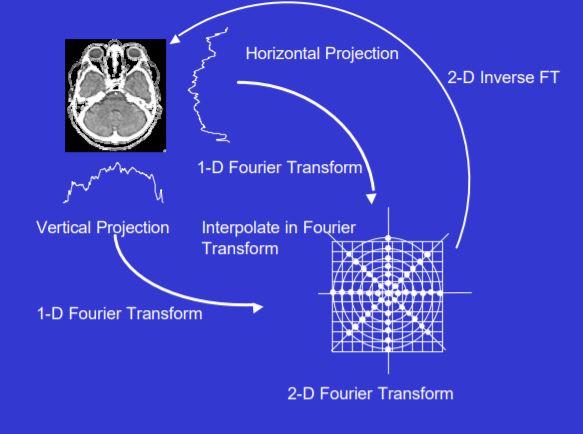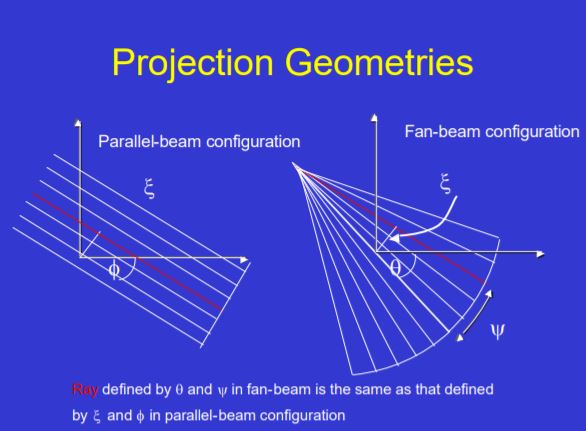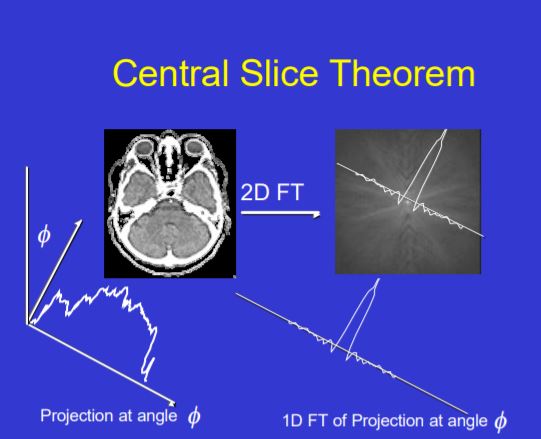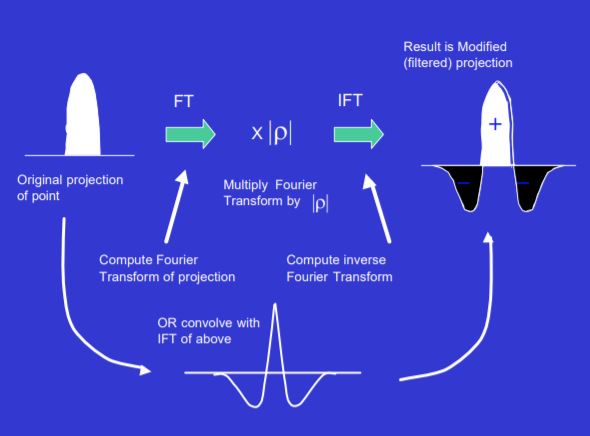【CT】Filtered Backprojection原理(parallel-beam&fan-beam)
个人觉得讲得比较好的是这个ppt。然后会对物理原理做一点补充,加一点自己的理解。
物理原理
首先CT要解决的问题:

已知光束和detector得到的平面图,求object信息。
物理学定律Beer‘s law:
$$\frac{d I}{d s}=-\mu(x(s)) I(s)$$
描述了光穿过物体的损耗,其中$\mu(x(s))$只与x(s)这个位置的物体性质有关,这也是我们要解的信息。对这个微分进行积分得到:
$$I_{x_{0}}(s)=I_{x_{0}}(0) e^{-\int_{0}^{s} \mu\left(x_{0}+\tau v\right) d \tau}$$
$$\log \left(\frac{I_{x_{0}}\left(\boldsymbol{x}_{\mathrm{out}}\right)}{I_{x_{0}}\left(\boldsymbol{x}_{\mathrm{in}}\right)}\right)=-\int_{s_{\mathrm{in}}}^{s_{\mathrm{out}}} \mu\left(x_{0}+\tau \boldsymbol{v}\right) d \tau$$
平行光束:
引入Radon变换:
$$\mathcal{R} f(t, \theta)=\int_{L_{t, \theta}} f(x) d S(x)=\iint f(x) \delta\left(\left\langle x, n_{\theta}\right\rangle-t\right) d x$$
The 1-D projection of the object, measured at angle $\phi$, is the same as the profile through the 2D FT of the object, at the same angle.
【在角度$\phi$的1D投影,和同一角度的2D傅里叶变换数值上相同】
在此基础上定义filtered backprojection:
$$f(x)=\frac{1}{2 \pi} \int_{0}^{\pi}(\mathcal{R} f(\cdot, \theta) * h)\left(\left\langle x, n_{\theta}\right\rangle\right) d \theta$$
$$f_{\mathrm{rec}}(x) \approx \sum_{k}\left(\mathcal{R} f\left(\cdot, \theta_{k}\right) * h\right)\left(\left\langle x, n_{\theta_{k}}\right\rangle\right)$$
这一段也是ppt讲得更加清楚:

If all of the projections of the object are transformed like this, and interpolated into a 2-D Fourier plane, we can reconstruct the full 2-D FT of the object. The object is then reconstructed using a 2-D inverse Fourier Transform.
【把所有方向都这样变换,就可以把数值插值到2D傅里叶平面,从而构建整个的傅里叶信息,再用逆傅里叶变换得到原物体信息】
这是平行光束的情况,用
-
将原始投影进行一次一维傅立叶变换
-
设计合适的滤波器,在φi的角度下将得到原始投影p(x_r,φi)进行卷积滤波,得到滤波后的投影。
-
将滤波后的投影进行反投影,得到满足x_r=r cos((θ - φ_i))方向上的原图像的密度。
-
将所有反投影进行叠加,得到重建后的投影。


扇形光束
对于扇形光束,转化为平行光束处理。首先介绍sinograph的概念:the 2-D array of data containing the projections,如果用平行光采集信息,角度为$\phi$ 距离为$\xi$,则平面$(\phi, \xi)$是这份数据的sinograph。事实上,我们完全可以把扇形光的sinograph调整为平行光情况,然后就可以按照平行光的算法处理:

The red ray in both the parallel and diverging configurations are the same, and therefore occupy the same point in sinogram space.
需要调整的是1.角度的对应关系;2.距离的对应关系【和光的强度有关】。具体的公式就没推了。
学习CT相关的知识主要还是为了看懂下一篇博文要写的论文:Deep Learning Computed Tomography,这篇算是看论文前学的基础知识。





